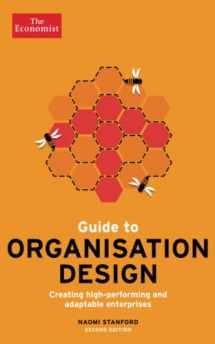
Guide to Organisation Design (Economist Books)
ISBN-13:
9781610395397
ISBN-10:
1610395395
Edition:
2
Author:
The Economist, Naomi Stanford
Publication date:
2015
Publisher:
The Economist
Format:
Paperback
356 pages
FREE US shipping
Book details
ISBN-13:
9781610395397
ISBN-10:
1610395395
Edition:
2
Author:
The Economist, Naomi Stanford
Publication date:
2015
Publisher:
The Economist
Format:
Paperback
356 pages
Summary
Guide to Organisation Design (Economist Books) (ISBN-13: 9781610395397 and ISBN-10: 1610395395), written by authors
The Economist, Naomi Stanford, was published by The Economist in 2015.
With an overall rating of 4.3 stars, it's a notable title among other
Management
(Management & Leadership, Systems & Planning, Strategy & Competition, Organizational Learning, Processes & Infrastructure, Strategic Planning, Human Resources & Personnel Management, Human Resources) books. You can easily purchase or rent Guide to Organisation Design (Economist Books) (Paperback) from BooksRun,
along with many other new and used
Management
books
and textbooks.
And, if you're looking to sell your copy, our current buyback offer is $4.59.
Description
Business failure is not limited to start ups. Industry Watch (published by BDO Stoy Hayward, an accounting firm) 'predicts that 17,043 businesses will fail (in the UK) in 2006, a further 4 per cent increase from 2005'. In America between 1990 and 2000, there were over 6.3 million business start-ups and over 5.7 million business shut-downs.
Risk of failure can be greatly reduced through effective organisational design that encourages high performance and adaptability to changing circumstances. Organisation design is a straightforward business process but curiously managers rarely talk about it and even more rarely take steps to consciously design or redesign their business for success.
This new Economist guide explores the five principles of effective organisation design, which are that it must be: driven by the business strategy and the operating context (not by a new IT system, a new leader wanting to make an impact, or some other non-business reason). involve holistic thinking about the organisation be for the future rather than for now not to be undertaken lightly - it is resource intensive even when going well be seen as a fundamental process not a repair job. (Racing cars are designed and built. They are then kept in good repair.)


We would LOVE it if you could help us and other readers by reviewing the book
Book review

Congratulations! We have received your book review.
{user}
{createdAt}
by {truncated_author}


